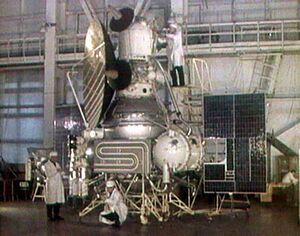Engineering:M-69 (spacecraft)
 | |||
| Manufacturer | NPO Lavochkin | ||
|---|---|---|---|
| Country of origin | Soviet Union | ||
| Specifications | |||
| Launch mass | 4,850 kg (10,690 lb) | ||
| |||
The Mars-69/M-69 or 2M was the designation given to 2 Soviet Mars probes that were to be sent in 1969.[1][2][3] Based on the Luna E-8 landers used for Luna 15-24 (including Lunokhod 1 and 2),[4] they were the first attempted Mars and Interplanetary Orbiters. The probes, however, were both destroyed in separate launches in early 1969.[2]
Development and Launches
After the landing of Venera 4 in October 1967, NPO Lavochkin looked at landing a larger probe on Mars with an Orbiter. Using the newer Proton-K (Blok-D), they could beat NASA's upcoming Mariner 6 and 7 probes in the 1969 Mars launch window. By modifying the E-8 lander, the original M-69 design was created with a lander. The M-69 bus was however changed with a hard lander before finally in 1969, the lander was abandoned due to time constraints.[2]
The first launch occurred on March 27, 1969, when Mars-69A (2M No.521) was launched.[1] Although the first two stages of the Proton-K worked, the third stage failed, and the probe crashed in the Altai mountains.[5]
The second and last launch (2M No.522)[1] on April 2, 1969, failed when the Proton-K Blok-D carrying it first had smoke appearing from the first stage[5] before it veered west, crashing near Site 81/23.[2]
Legacy
After the failure of M-69, NPO Lavochkin redesigned Mars-69 to allow for a landing on Mars in 1971. This design would become the M-71,[5] the first version of 4MV bus.[4]
References
- ↑ 1.0 1.1 1.2 "Mars M69 #1, #2" (in en). https://space.skyrocket.de/doc_sdat/mars-69.htm.
- ↑ 2.0 2.1 2.2 2.3 "M-69 Mars missions". http://www.russianspaceweb.com/mars69.html.
- ↑ "Mars M-69". http://astronautix.com/m/marsm-69.html.
- ↑ 4.0 4.1 "First Pictures of the Surface of Venus". http://mentallandscape.com/V_Lavochkin2.htm.
- ↑ 5.0 5.1 5.2 Perminov, V.G. (1999). The Difficult Road to Mars. NASA. ISBN 0-16-058859-6.


